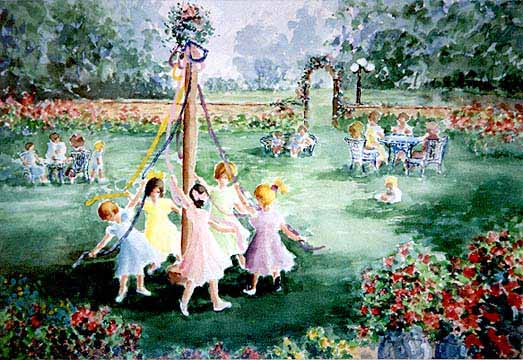May Day: A Pagan Festival
Today is May Day and people across the Western World are celebrating (or protesting) in various ways, but very few appreciate the significance of this particular point in the calendar. Today, it has become most closely associated with socialism/communism. It’s co-opted by left-wing groups who rename it Labour Day or International Worker’s Day, as stipulated by the Second International in the late 19th century. In the past this version of May Day was widely celebrated in the Soviet Union, and today it still bears great significance in Cuba and the People’s Republic of China as a symbol of the proletariat’s political power. However, this apparent celebration of class warfare is by no means the origin of May Day celebrations, which predate the very notion of Marxism by over a thousand years. Indeed, May Day has been a celebration of particular importance across Germanic Europe since pre-Christian times and it’s always carried a sacred element. This may, perhaps, be of lesser importance in today’s secularised Europe, yet again it’s an example of Europeans inadvertently returning to their roots.
In England, Germany and Scandinavia, May Day is a remnant of pre-Christian Pagan times, just like many other of our secularised and/or Christianised festivals – Christmas (Yule), Easter (Ostara) and Halloween (Winter Nights), to name but a few. In Anglo-Saxon England, May Day marked the beginning of Þrimilce-mōnaþ or ‘Month of Three Milkings’, whilst the Old High German for this period translates to ‘Pasture Month’ – in both cases, the dates loosely correspond to the modern month of May. The precise significance of the May Day festival varies from region to region, but broadly speaking May Day festivities are a celebration of the beginnings of Summer, as well as fertility of man and soil. In England, as all the seeding would have been completed by this point in the year, May Day was traditionally designated as a public holiday for farm workers. This became a day on which communities used their free time to come together, but whether or not a Maypole was erected in pre-Christian times is unclear – the earliest recorded use of this was in the mid-14th century. This tradition has persisted in rural parts of England, with villages and towns across the country fully embracing the community spirit. In the present day, a Maypole is erected and the traditionally English Morris Dance is a popular attribute. Interestingly, May Day celebrations were banned in England under the reign of Christian purist Oliver Cromwell, presumably because they’re “heretical” – he banned Christmas for much the same reason.
In Germany, May Day traditions vary greatly by region. Generally speaking, Germans observe the festive period from the night of April 30th through to 1st May, with the former being the time for the more traditionally pagan elements; bonfires, feasts and the like. Historically, Germans believed that Witches held a satanic celebration (Walpurgis Night on the night of 30th April, and therefore would light a bonfire and create quite the commotion with singing and dancing so as to warn off any unwanted Witches. This has led the evening before May Day to become known as Witches’ Night (Hexennacht). There is also the love and fertility parallels as with Anglo-Saxon society; in the Rhineland, young German men would decorate a Maypole with ribbons to leave on May Day morning for the girl they’d like to marry – a Maypole dressed entirely in white, however, is a sign of frosty relations. Girls would leave rice or roses in the shape of a heart outside of their love interest’s house, except on a leap year when these roles are reversed. In contemporary times, Germans hold well-attended marches in the cities on May Day to celebrate workers rights, or to campaign for more. With that being said, rural communities still celebrate this day in the traditional way.
![]()
A theory for why the Maypole was traditionally a tree or a tree stump is that Germanic heathens in England, Germany, Scandinavia and so on often acknowledged a sacred significance of them. This is why, for instance, the “Christmas” (Yule) Tree was popular symbolism around Midwinter.
In the Celtic countries, the Pagan May Day festival is known as Beltane. This has been adopted by modern Wiccans.
Interestingly, England does not designate May Day as a public holiday, instead having what’s known as the Early May Bank Holiday on the first Monday of May. Of course, if the first Monday happens to be May Day, then the two coincide, yet this is obviously a rarity. May Day has been a public holiday in Germany since 1933, when the nascent NSDAP government designated it the National Day of Work and a public holiday. Similar celebrations held by Communists and Social Democrats, aping the Soviet Union, were banned, but obviously this restriction was lifted after 1945. May Day in Germany has been known to be hotly politicised, with riots erupting as a result of radical leftist agitation or clashes between left and right-wing groups. Across the Scandinavian nations, May Day or, Labour Day, as it’s more commonly referred to as, is either a full or partial public holiday. Finland appears to celebrate this day particularly enthusiastically. Vappu, as it’s known in Finland, is one of the most important dates in the calendar and has been a celebration of Springtime since the Pagan era. Needless to say that, given the socialist tendencies of Scandinavia, “Labour Day” is especially popular in the modern era.
In the Soviet Union, both the 1st and 2nd of May were public holidays, a tradition inherited by Ukraine today. Back in Soviet times, the International Day of Workers’ Solidarity as it was then known was inherently important, often attracting vast crowds to the streets of the major cities. This is something the Soviet Union shared with other 20th century communist countries, most of whom – China, Cuba etc – have continued to revere its significance to this day. In post-war East Germany, Labour Day was also popular with the state for obvious reasons. It’s claimed that workers were expected or even coerced into joining the processions to display the socialist solidarity that the GDR wished to portray to the world, however by all accounts the majority of the population bought into this theme.
May Day/Labour Day is a conflation that leaves one with rather mixed feelings. On the one hand, it’s unfortunate that an inherently European Pagan festival has been bastardised by international communism. However, it is rather fitting with the folkish ideals of community and brotherhood that a day of proletarian solidarity should be amalgamated therewith. For the archaic notions of family, kith and kin and so on were inherent within all Pagan festivities, especially May Day. Yet it is somewhat frustrating to witness armchair communists across Europe reserve their one day of political action for a sacred festival, which they inevitably debase with their deviant tendencies.
Let that not distract from the point at hand, however. May Day is a celebration that is intrinsically European, and as such should be promoted and conserved wherever we are fortunate enough to have still held onto this festival. Particularly in England and parts of Germany, the Pagan elements have stood the test of time, and are a reminder to Europeans that their souls are firmly rooted in the spirit that these festivals were held; cooperation with and consideration for the wellbeing of one’s own community.
Please, share this post on Facebook !

